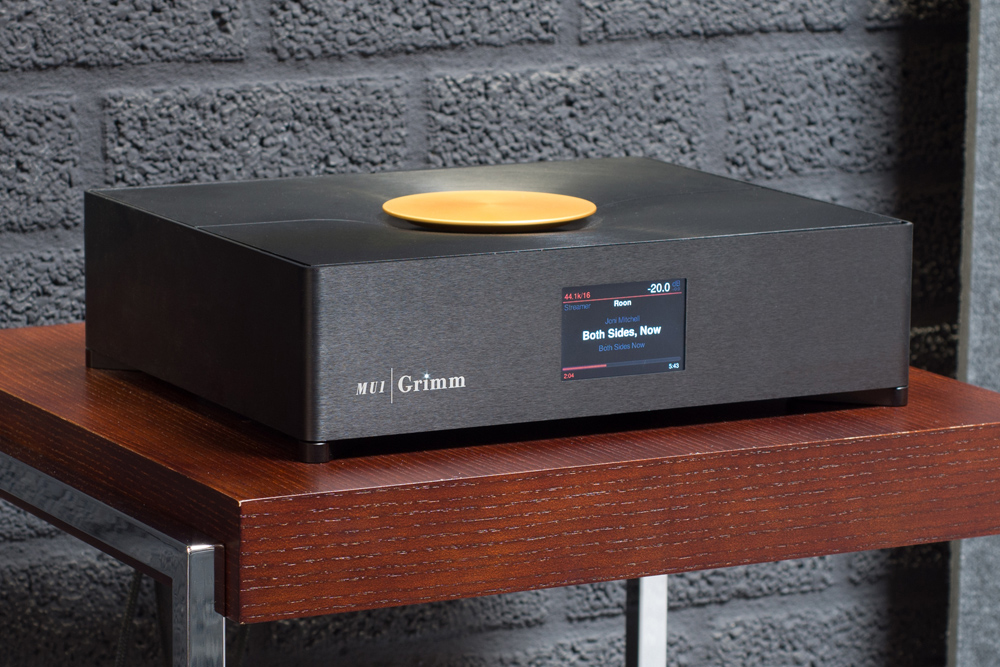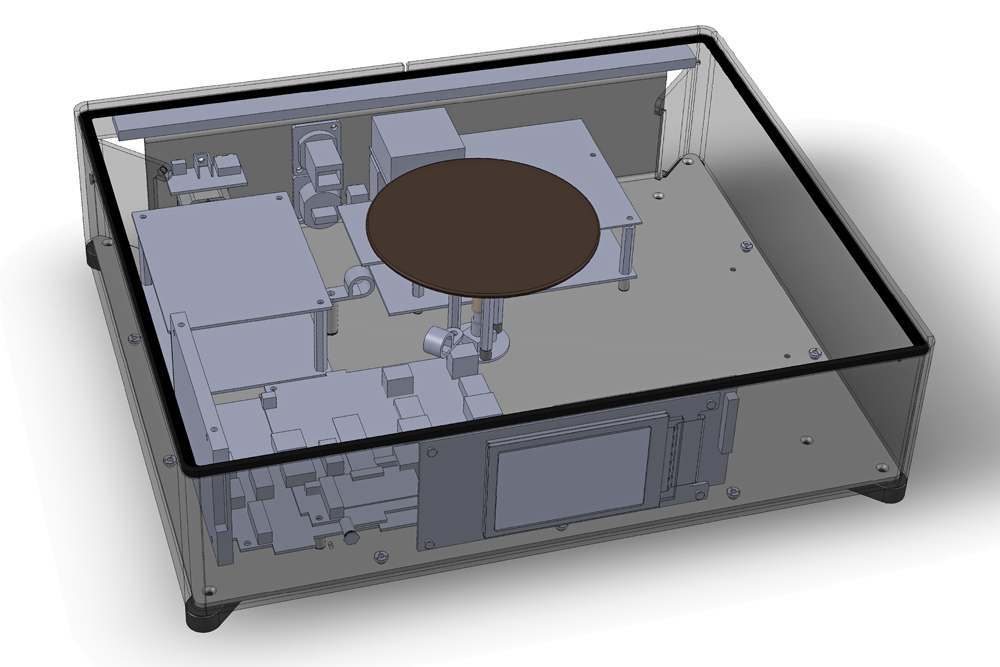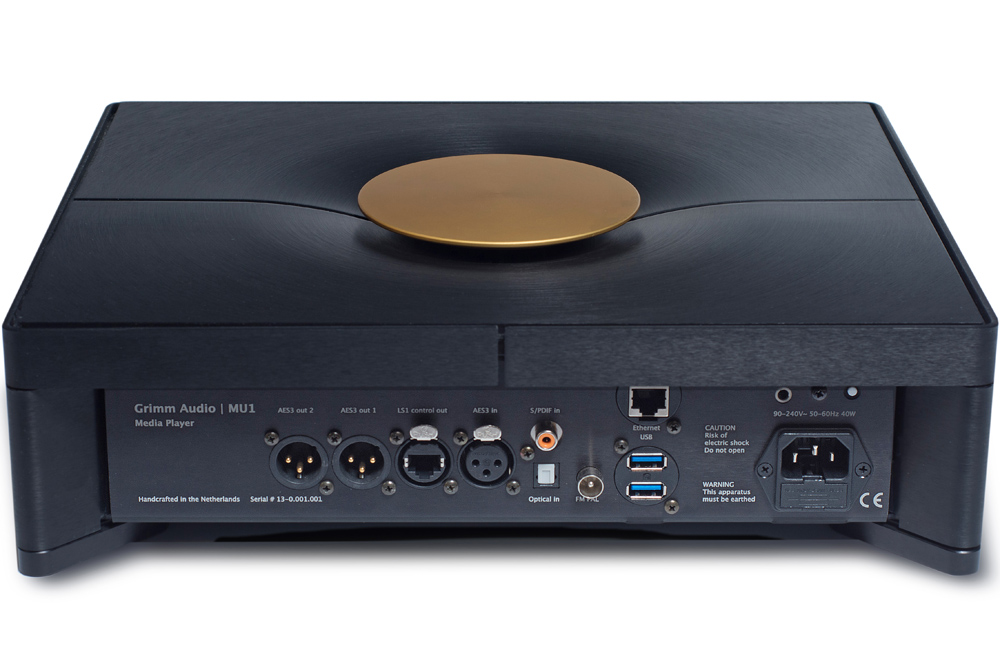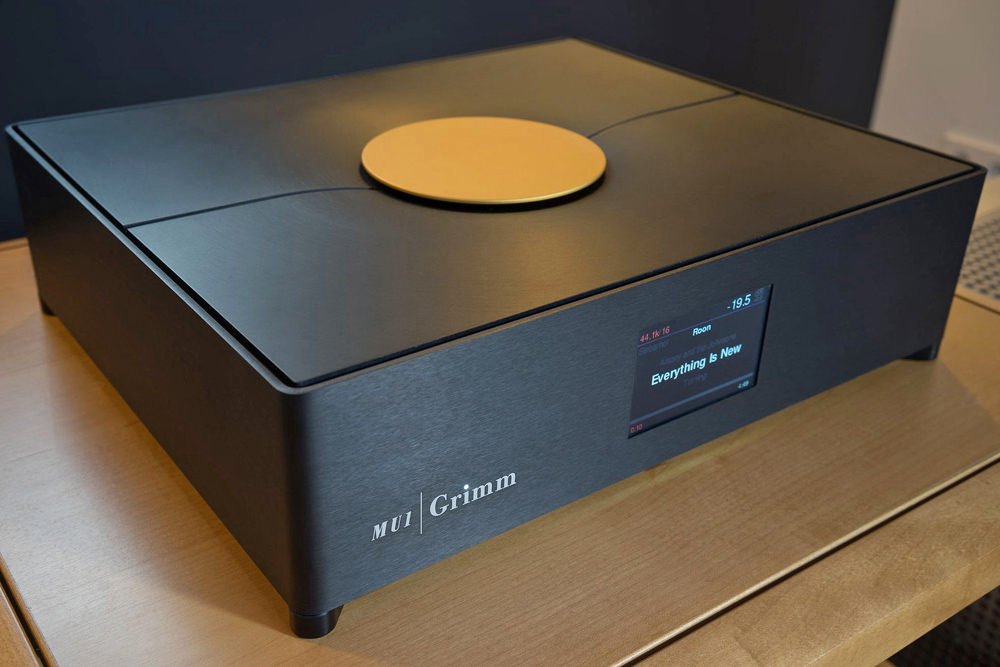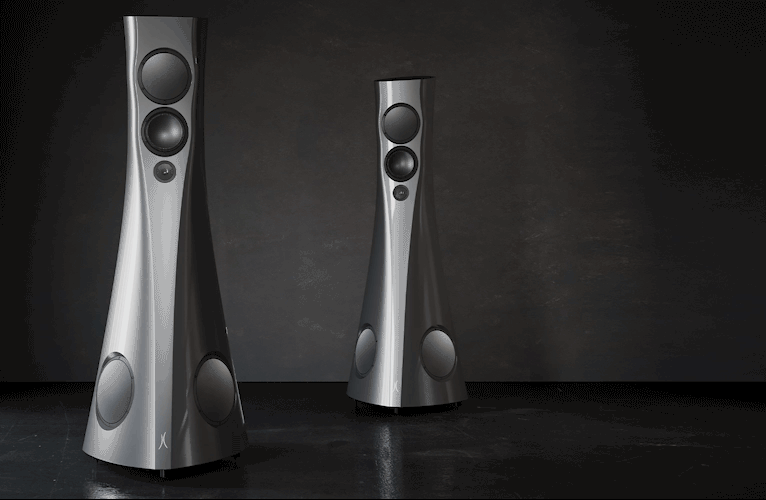Grimm Audio was founded in 2004 in Eindhoven, The Netherlands, the original home of Philips. Grimm Audio was started by Eelco Grimm with Guido Tent, Bruno Putzeys and Peter van Willenswaard. Bruno Putzeys departed to concentrate on Class-D amplification, and Peter van Willenswaard has since retired. Grimm Audio’s first product was the AD1, a DSD64 output A/D convertor designed and developed for the pro-audio industry. In 2010, ‘Grimm’ diversified and embraced the home consumer market when it introduced the LS1 digital active speaker system. In late 2019 Grimm launched the MU1 music server/player which can directly connect to the LS1 to create an elegant music system. Here, we’re examining the MU1 as a high-end standalone digital music player.
Anything But Grim
Eelco Grimm is the Creative Director: sound engineer, concept developer, system thinker and communicator. Eelco was former Editor-in-Chief of the leading Dutch professional audio publication Pro-Audio Magazine. He is still a lecturer and researcher at HKU University of the Arts Utrecht, Music and Technology. He’s also an internationally recognized expert in ‘Loudness Normalization’ matters, contributing to EBU R128 for broadcast and AES TD1004 for music streaming.
Guido Tent is the Technical Director of Grimm Audio. He is an electrical engineer and is responsible for development, supply chain and sales. While at Philips, he specialised in analogue electronics, RF and EMC (silicon and system design). He was also a former lecturer at Fontys University of Applied Science, Eindhoven. He runs his own company called TentLabs in parallel with his work at Grimm Audio. He’s a big music lover and attends classical live performances regularly.
Together, Eelco and Guido are the expert and guiding partnership behind Grimm Audio. In fact, while sharing premises from the start, Grimm Audio and TentLabs have moved to brand new premises in Verdhoven.
Grimm Audio advertises the MU1 as “The ultimate digital music source”. It is also a streamer and a hub that allows you to connect multiple digital devices. Since the MU1 user interface is Roon-centric, it can easily stream services like Qobuz and Tidal.
The MU1 is built on key philosophies that guide Grimm Audio in its development of its products. Those philosophies mandate an incredible jitter-free clock, extremely accurate upsampling/downsampling and a stable low-noise power supply. Each of these three “hearts” will be covered in this review.
After much research, Grimm Audio determined that clock jitter is much more important than super-high PCM sample rates or DSD. That statement alone will likely raise the eyebrows of a good many audiophiles. But the company firmly believes that jitter is an evil that must be eliminated. Grimm Audio is known for its low jitter word-clocks used in studios around the world – the CC1 comes to mind. The clock inside the MU1 is the CC1 clock, a radically redesigned discrete crystal oscillator with clock stability that betters the best test equipment available today. To get advantage of this low jitter clock in your DA converter, it needs to be connected to the MU1 via AES-EBU or S/PDIF since that’s the only interface that carries both data and clock.
The real heart of the MU1 is its FPGA (Field Programmable Gate Array). All the code for their FPGA has been written by Grimm Audio. This is not a trivial job – programming an FPGA requires a lot of expertise, knowledge, time and effort. In other words, it’s very expensive to develop. Work on the MU1 started in late 2016, and the first MU1 was launched in 2019. The MU1 FPGA is responsible for the upsampling and downsampling of sample rates.
Regarding these sample rate conversions Grimm told me:
Whenever audio is up or down converted from one sample rate to another a filter is needed to remove frequencies that are above half the lowest sample rate of the two, which is called the ’Nyquist frequency’. The up- and downsampling filters of the MU1 have extreme resolution in all dimensions. We discovered that precision like this is needed to recover microdynamic detail from humble CD tracks as well as from pristine DSD files.
In the MU1 [our] technology helps to reduce the errors in oversampling filters of downstream DA converters, by replacing their first, most calculation intense internal oversampling step with an extremely high precision one in the MU1. In addition, the low jitter clock of the MU1 ensures an extremely low jitter AES or S/PDIF output signal that improves the timing accuracy of any locked converter.
The clock used to govern the FPGA processes is a Tentlabs clock, “a bit of overkill I agree” Grimm says with a smile, going on to say:
The sonic improvements are probably best characterised as ‘regained resolution’. […] Performance finally seems to become in line with the quality indicated by the measurement figures and the mathematical laws of digital sampling as posed by Harry Nyquist in 1928. We therefore call it “Pure Nyquist”.
The MU1 runs Linux and Roon on a NUC – an Intel i3 dual core processor with 4GB memory and a 120GB SSD disk for the OS. An i3 NUC may appear to be underpowered for the job of running Roon. In usage however, performance of Roon was excellent. (Note: my library has 2050 albums, small compared to some). When asked about the processor choice, Eelco told me,
We use the fastest computers that do not need active cooling, which means i3 processors. An i7 will mean you will hear a fan. The MU1 is intended as an elegant ‘one box’ solution, which means we need passive cooling. By the way, the difference between an i7 and i3 can only be noticed during start-up and the initial indexing. In normal use the speed of the tablet that runs Roon Remote has a bigger impact.
Note that all the important libraries used by the Linux OS have been meticulously re-written by Grimm Audio to ensure speed, control and efficiency.
We use as few code libraries as possible since we want to have control of everything that runs in our system, plus we love elegant code. Of course, we use Linux but it is a bare bone ‘tiny OS’. The full control system of the MU1 has been written by us. Roon is of course used ‘as is’, we cannot interfere with that.
All that said, remember that the FPGA does most of the heavy processing inside the MU1, not the NUC. Judging by the sound quality, I’d say that the FPGA is extremely accurate and fast.
The SMPS power supply of the MU1 is a thing of beauty, and could be considered to be another “heart” of the MU1. It’s a two-tiered affair that produces smooth stable DC voltage without contaminating the internal circuitry of the MU1 itself or other devices on the same power line. Grimm Audio say that it has been developed in such a way that it is immune to the power cord used provided the cord is of good quality and properly grounded. More on this later.
The only physical control on the MU1 is the large gold wheel or dial on the top. You use this with short pushes, long pushes, turns and turns while you push. The extensive online manual explains it all so I won’t repeat it. Suffice to say you can use the wheel to turn on/off the MU1, scroll through the menu system, select options in the menu system, select channel and control volume.
Speaking of the volume control, Eelco had this to say about it,
A lot of effort went into the MU1 code to make sure that more resolution is preserved than in standard implementations. It will be very hard to find an analog volume control that performs better.
In a comparison of the volume control in my Trinnov Amethyst to the MU1 volume control, I favoured the MU1 instead. I used the MU1 volume control for most of my listening.
Connections provided include four digital audio outputs (two generic AES3, one S/PDIF and one Grimm Audio LS1), three digital audio inputs, an FM cable input (functionality to come), an ethernet network connector, two USB connections for external storage and a 3.5mm socket for an external IR remote sensor. There’s a small power switch and an IEC mains power connector. The MU1 weighs 4.5 kg. Dimensions are 355mm wide x 295mm deep x 100mm high.
There are many different ways to get a signal out of the MU1 and into your downstream DAC/device. However, it’s at this point that you have to decide whether you wish to follow the recommended path laid out by Grimm Audio and abandon the current connection favourites (USB and ethernet) in favour of AES-EBU or S/PDIF. Being a Roon device, the MU1 can handle USB or ethernet to your DAC/device. So if you wish, you can use the USB or ethernet output from the Grimm into your downstream DAC/device. However, this will bypass the FPGA and will therefore obviate the main reason for using the MU1 in the first place. If you bypass the FPGA, the result will be a signal quality no better than say, a Mac Mini configured as a music server (my previous setup). If you want the real magic (and who doesn’t?), then you must use the AES-EBU or S/PDIF output to take advantage of the FPGA. Note that the newer versions of the MU1 (builds from August 2021) now include an S/PDIF output, which also takes advantage of the FPGA. The Grimm proprietary LS1 loudspeaker output connection also has the FPGA magic endowed.
So, when you select the AES-EBU or S/PDIF output, this is where the FPGA comes in. You can tell it how you wish to oversample, whether you want No-oversampling, ‘2FS’ or ‘4FS’. ‘No-oversampling’ means that the FPGA does not alter the signal, unless the rate is DSD or ‘8FS’ in which case it down-samples to ‘4FS’. ‘2FS oversampling’ means that 44.1 kHz will be upsampled two times to 88.2 kHz, and 48 kHz will be upsampled two times to 96 kHz. ‘4FS oversampling’ means that the audio will be upsampled four times to 176.4 kHz or 192 kHz. ‘8FS’ (aka DXD) and DSD will be down-sampled to 176.4 kHz or 192 kHz. The ‘4FS’ setting is the default and recommended setting.
Of course, this is all required because the S/PDIF and single-connector AES-EBU specification will accept a maximum of 192 kHz. At this point you might be thinking, well, why would I want to potentially down-sample? Isn’t it better to go for ever higher sampling rates, like ‘8FS’ or even ‘16FS’...? The answer comes back to what Grimm Audio’s extensive research has found: that jitter is much more important than super-high PCM sample rates or DSD and AES-EBU or S/PDIF is needed to get that clock quality into your DA converter.
Throwing Abandon to the Wind…
For some audiophiles, it may be difficult to abandon USB or Ethernet output in favour of AES-EBU or S/PDIF. After all, many have held the belief for years that these output formats are the best. I asked Eelco if he had noted any resistance to this change…
That education is based on their experience, which is good. However, they should have experience with the MU1 before they comment on it. The MU1 is ‘totally’ different than the general computers they are used to (audiophile power supply, optimised system, superior clocks, etc.) so their former knowledge does not help them.
If they question it but haven’t tried it, then Eelco politely asks them to do so. If they have tried but still have concerns, then Eelco is very prepared to listen.
Grimm Audio suggests that neither the output AES-EBU cable nor the power cord is super important to achieve superb sound. The company provides its own inexpensive TPR cable (on request for a modest charge) for AES-EBU duties and a stock standard power cord terminated properly for your country (very rare in my experience). But Grimm Audio is very open-minded and is happy if customers wish to use other cables.
My review MU1 came with an 8TB SSD internal disk for storing music. To see that disk from a Mac, either click on it in your list of network devices, or click “Connect to server” in Finder (logon as Guest). From a Windows 10 PC, map to it in File Explorer by using the IP address of your MU1. (The IP address can be found in the MU1 menu options.) You then just have to copy your music files to the /HEAP area, and Roon will automatically index them. Note that if you have your music on a USB disk drive attached to the MU1, then you cannot remotely see it or copy to it. You have to plug that USB disk into a computer that allows you to copy your music to it, and then connect it again to the MU1. This is somewhat inconvenient and probably a good reason to use the internal SSD (preferential IMO) or a NAS drive.
The manual is an excellent source to help you through the initial setup of the MU1. Although I’d read it in advance, I got flummoxed by the message “No Connection” when I first started my setup. I interpreted it to mean there was no network connection. My bad, the manual is quite clear. It actually means the MU1 could not connect to a controller, i.e., a remote tablet. Without that connection, the MU1 is basically unusable, so it makes sense that the initial setup needs that configured.
At the time of writing, the just-released MU1 firmware version (V1.3.0) includes the ability to take any remote control and program the MU1 to recognize basic functions like volume control and input selection. For this to work, you need to have an infrared receiver and plug it into the “remote” connector in the back of the MU1. I didn’t have such a receiver so I didn’t test this functionality (the "remote" connector is now supplied with MU1 and the review sample was the very last unit which did not include it). The V1.3.0 release also activates the S/PDIF output.
For the best sound possible, the MU1 must be set as the Roon Core and the Roon Endpoint. In other words, don’t connect to an external Roon Ready device like a DAC. And you must use either the AES-EBU, S/PDIF or Grimm LS1 output and have that send signal to your DAC/device.
The MU1 is shipped with Roon pre-installed. The use of Roon is required. You must have your own Roon licence; this is not provided by Grimm.
Lastly, note that the ‘Grimm LS1’ output connector may look like an ethernet connector, but it is proprietary to the Grimm LS1 loudspeaker system. It will not work with similar systems like that from Kii Audio or Dutch & Dutch, for instance. Grimm recommends that you do not plug an ethernet connection into the LS1 output connection.
Let the Music Flow…
To my ears, Roon has always sounded a bit heavy/rich with a less dynamic, less exciting and less involving sound than music server players such as Audirvana. When you choose to use the MU1 AES-EBU or S/PDIF output (or LS1 output to LS1 speakers), then you are using the FPGA which totally eliminates that degradation – the resulting sound is full of energy, life, incredible resolution, depth and tonal beauty… all without imparting any harshness or brightness. You don’t need to listen long to hear the effect – just a bar or two will suffice. I do really like Roon’s ability to pull together all the many links in my music and present it in a clean and coherent manner but I have always struggled a bit with its SQ engine. Now I can bypass it altogether.
I experimented with the over-sampling settings but chose to stick with the ‘4FS’ over-sampling. It seemed to impart more life and air plus a sense of depth and better sound staging. All my listening comments reflect the ‘4FS’ setting.
I also tried different power cords and AES3 cables. As mentioned, the Grimm Audio MU1 came with a stock standard power cord with the proper plug for Australia. I had two other cords that I tried, a Quantum Resonance Technology cord (pre-Nordost buy-out) and a JPS Labs AC-X. I could definitely hear a difference in these three power cords. The stock cord created a slightly veiled laid-back sound and transients were slightly blunted. The Quantum cord, with its silver over copper micro-filament conductors (like Nordost), created an extremely detailed sound but was also somewhat etched and thin. The JPS AC-X proved to be in the middle – smooth, open, good body, weight and clarity, with no hype. Just natural.
At my request, my MU1 came with the very affordable Grimm Audio TPR AES3 cable. In a comparison to a Nordost TYR 2 AES-EBU cable, the TYR 2 provided better openness and transparency. Under comparison, the TPR portrayed less vitality and seemed slightly veiled. The TPR cable was very good though and you could probably live happily with it if you didn’t compare it to anything else. However, my preference was for the TYR 2 cable, so most of my listening was with this cable.
I then tested the MU1’s new S/PDIF connection. I compared the TYR 2 AES-EBU to the Anticables ‘Level 6.3 Digital RCA Interconnect’ (S/PDIF). It may seem like an unfair comparison, but the Anticables S/PDIF performs above its price bracket. Playing “Stille, Stille Kommer Vi” from A Quiet Winter’s Night by the Hoff Ensemble, it seemed that the S/PDIF had better depth and was more open with slightly better body but slightly softer sounding. The AES-EBU had faster transients, tighter bass and better mid-range clarity – it was more controlled overall. Both sounded great spatially with natural tempo. This was also apparent playing “Manitoba Man” from the Colter Wall album Song of the Plains and “Mountain of Blues” from the Buddaheads’ album Wish I Had Everything I Want. I felt that what cable sounded best really depended on the music being played.
Late during my review, I received a new Jorma Design AES-EBU cable. I let it run in for about 30 hours before any serious listening – possibly not enough but I could already sense the character of the cable. This cable has had rave reviews by Christiaan Punter of HiFi-Advice, often when hooked up to the AES3 output of his MU1. His MU1 often feeds directly into his CH Precision DAC, then into a CH Precision amplifier. My review MU1 feeds into a Trinnov Amethyst, then a Weiss Medus DAC, then into a Gryphon Antileon EVO amplifier. Both the Weiss DAC and the Gryphon amplifier have a slight warmth to them, more so I suspect than the CH Precision equipment. So, in my system, I found I did initially favour the TYR 2 AES-EBU cable. The Jorma cable is definitely a superb cable, and by the end of my review the Jorma had “run in” further and I found I had a preference for it (!). The difference between the two is subtle but noticeable, the Jorma being slightly warmer and natural sounding. That said, I do have both cables hooked up because the MU1 supports two AES3 outputs. So now I can easily switch between the two depending on the quality of the recording, my mood, the type of music, etc.
Because the MU1 always converts DSD to PCM in its FPGA, I wanted to see how the converted DSD files compared sonically to PCM files (Note: all comparisons were through the TYR 2 AES-EBU connection). Playing the track “Stille, Stille Kommer Vi” again from A Quiet Winter’s Night by the Hoff Ensemble, I found the bass was too heavy sounding in DSD. The vocals seemed less distinguishable on the DSD as well, although depth seemed better. With the PCM version (88.2/24), transients had more snap without hardness, and piano, cymbals and drums sounded more natural. On the downside, the PCM version seemed to have less depth and felt less free flowing than the DSD. I got similar results playing Patricia Barber’s “Yellow Car III” on Café Blue (96/24). The DSD was sweeter, fuller but the bass was too loose for my liking. The PCM sounded slightly less dimensional but bass was tighter and less bloomy and drum rolls were more distinct, the prominent descending bass line repeated in places was clearer. Other albums like Cool Jazz (DSD256 from NativeDSD) by the Gabor Varga Jazz Trio sounded absolutely great – there was no excessive heaviness in the bass. Without a doubt, the DSD to PCM conversion by the MU1 was noticeably better than the DSD to PCM conversion by Roon itself.
Moving on to other aspects of the music, the track “The Traveller” from the album Looking for You (44.1/16) by Allan Taylor is a track I’m very familiar with. It sounded very natural with no excessive warmth, the voice had great humanity and feeling, guitars shimmered wonderfully, bass was full and solid but not too intrusive into the mid-range. Transparency and resolution deep into the sound stage was superb.
The Loreena McKennitt track “Kecharitomene” on her album An Ancient Muse (44.1/16) is a very busy track. But the MU1 cohesively presented the various musical threads with great tempo, dynamics, flow and energy. I could listen to individual instruments and her voice – all was presented with excellent resolution and tonal balance.
A friend of mine asked how Qobuz compared to the same music on the MU1’s internal SSD. Of course, you cannot be sure that the music file is the same in both instances, even if it’s the same sampling rate and bit depth, and the same format. Nevertheless, I spun a few tracks to see if I could hear any differences. I did get the impression that Mark Knopfler playing “My Heart Will Never Change” from Tracker (FLAC 192/24) was a bit more expansive, had slightly better detail and flowed better from the internal SSD. Andrew Manze’s violin on The English Concert playing “Allegro” (Violin Concertos No. 4 in D Major) from the album Mozart: 3 Violin Concertos, seemed to have a bit of an edge in the Qobuz version. The more I listened and compared Qobuz to local disc files, the more organic and natural the local files sounded. Admittedly, there were times when I thought less well recorded material was from Qobuz and excellent recorded material was from the local files, only to find I was quite wrong. But with familiar material, local music files just sounded more right, more natural with slightly better resolution.
What Does the Future Hold?
In early September 2021 Grimm Audio released a new MU1 version (V1.3.0) that activated the new S/PDIF output. It also included menu functionality giving you the ability to take any remote control and program it for simple instructions like adjusting volume, changing inputs/channels, etc.
A MU1 menu system (and a LS1 menu system) accessible from your remote tablet is in the pipe line, but Grimm has no firm release date [Editor - Grimm Audio has notified us that the update is due early April 2022 and, in his words, "it not only includes the MU1 & LS1 menu system via browser control but it also adds (optional) surround sound playback and... even further improved up and downsampling algorithms. Beta testers were stunned..."] . The next release will add surround sound playback. FM input activation has been put on the back-burner due to other releases.
Contrary to rumours, Grimm Audio has no plans to create its own controller/presentation user interface to give customers the choice of Roon or a proprietary UI. The company is fully aware that it would be a major undertaking to create a Roon, Audirvana, etc. competitor. That isn’t in their business model.
The talked about MU2 (a MU1 with an embedded DAC) is planned for 2022. Still no word on the type of DAC (i.e.R2R, Delta-Sigma, FPGA). My best-guess would be FPGA.
I asked Eelco if there are any other products planned for the home consumer market, to which he responded “Not at this moment no. But we will not stop developing of course”.
Conclusion
The Grimm Audio MU1 is the first electronic component I’ve come across that sounds so very much alive. By alive I don’t mean that it sounds like live music – I don’t think we’ll ever get to where a big orchestra playing in a huge concert hall can be convincingly scaled down into a Hi-Fi system in a considerably smaller room. And it isn’t just the sense of scale, but also the tonal balance and dynamics.
All that said, the Grimm Audio MU1 sounds so alive in that it is so incredibly vibrant and joyful to listen to, so transparent with extremely high resolution, so tonally balanced, so fluid, so dynamic. And yet it does all this without any glare or harshness – it always sounds like music; music you can listen to for hours on end without fatigue. The MU1 draws you into the music so that you do feel a real emotional connection. A number of times I was quite moved by the music [read... tears in the eyes]. That it could do that to this somewhat jaded audiophile is quite amazing.
So yes, I really liked it. So much so that I’m buying it. The “ultimate digital music source” gets a very solid recommendation.
… Tom Waters
www.soundstageaustralia.com
Associated Equipment
- Speakers — PMC MB2 SE speakers with ANTICABLES Level 5 Signature jumper wires
- Amplifier — Gryphon Audio Designs Antileon EVO
- Preamplifier — Trinnov Audio Amethyst
- Sources — Grimm Audio MU1 Music Server, Gryphon Mikado Signature CD Player, Weiss Medus Reference DAC
- Processor — Trinnov Audio Amethyst
- Cables — ZenSati #1 and #2 interconnects and speaker cables, Nordost Tyr 2 AES-EBU, Jorma Design AES-EBU, AudioQuest Vodka Ethernet cables, sILENzIO S/PDIF, Trinity power cords, Synergistic Research Hologram A and D power cords, ANTICABLES Level 3 Reference power cords (in/out of Nordost QX4 line purifier), Nordost Purple Flare (Figure 8) power cord (router)
- Audio Rack — Schroeders and Schroeders, Symposium Ultra custom-made amplifier stands
- Miscellaneous — Nordost Quantum QX4 line purifier, Nordost Quantum QV2 AC line harmonizers, Nordost Quantum QK1 AC Enhancer, Nordost Quantum QB8 power distribution, Townshend Seismic Podiums, dedicated 20 amp power lines, Symposium Rollerblock Jr isolation footers, Symposium shelves, Viablue UFO XL Absorbers, Vicoustics bass traps and diffusers, RealTraps bass traps
Grimm Audio MU1 Digital Music Player
Price: AU$21,995
Australian Warranty: Five Years
Australian Distributor: Advance Audio Australia
+61 2 9561 0799
www.advanceaudio.com.au
Grimm Audio
Zandven 6
5508 RN Veldhoven
The Netherlands
+31 40 213 1562
www.grimmaudio.com






